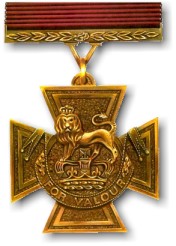WILLIAM ANGUS VC
THE MEDAL
In 1854, when Britain became involved in the Crimean War, there was a problem of low morale, generally caused by poor leadership and communication. A major part of this problem was the tendency for battle awards to be made to command and staff officers who were far removed from the action. This war was the first one in which regular media reporting was fed back to the British public, and conditions at the front were soon the cause of concern at home.
The effects of this were recognised in London, and led to a proposal from Liberal MP Captain Thomas Scobell, an ex naval officer, that an 'Order of Merit' be struck, to honour acts of outstanding bravery. This suggestion was pursued by Lord Panmure, the War Secretary, who forwarded the suggestion to Prince Albert. Shortly thereafter Queen Victoria announced the new medal. It was to be awarded only to soldiers who had performed an act of signal bravery or devotion, with such act carried out in the presence of the enemy in order to qualify. It was intended to be the most highly prized military award, and was uniquely available to all ranks.
The Queen took a great personal interest in the commissioning of the medal, and several alterations were made at her request, or that of Prince Albert. These related to the criteria, size and style of the medal. Most notably, Albert was responsible for changing the title from 'Military Order of Victoria' to the 'Victoria Cross'. The Queen in turn changed the wording on the medal from 'For the Brave' to 'For Valour'. Her reason for that change was to avoid the suggestion that only those awarded the Cross were brave in battle.
It was decided that the medal should be made retrospective to 1854, and on 26 June 1857, Queen Victoria decorated 62 Crimean War recipients during a ceremony in Hyde Park. Since then, the medal has been awarded only 1,354 times, although only 1350 medals have been struck. Three men have been awarded a bar to their VC, and one award was made to the Unknown Warrior who lies in Arlington Cemetery, USA. (The Unknown Soldier in Whitehall has the reciprocal award of the Congressional Medal of Honor).
The medal itself is cast from bronze, attributed to Russian guns captured at Sebastapol. In fact the metal used during and after WW1 came from two 18 pounder Chinese guns that had been at Woolwich Barracks long before the Siege of Sebastapol. The Chinese metal was so hard that it was necessary to cast the Crosses rather than stamp them, the effect of this being a much more detailed medal than was originally envisaged. It is made by Hancocks & Co, Jewellers, who have made every Victoria Cross since 1857. The company hold the metal in ingots, each capable of making six Crosses, and they cast them in batches of six as required. Every medal is hand chased to enhance the detail, and then bronzed to a uniform finish. This process can lead to each medal being a slightly different colour and weight from others.
|
The medal is in the shape of a Cross Patté, suspended from a straight bar with an integral lug in the form of the letter 'V' for valour. It is the reverse of this bar that carries the engraved details of the recipient's rank, name and regiment. The rear of the medal is engraved only with the date of the action, in the format 12 JUN 1915 |

|
The ribbon is crimson. Between 1856 and 1918 the medal used two different ribbons, blue for the Navy and crimson for the Army. Just prior to the 1918 formation of the Royal Air Force, it was decided that all services should use the crimson ribbon. |
| Until 1977, the VC was the only British medal that could be awarded posthumously. | |
| It is estimated that the chance of surviving a VC action is no greater than 1 in 10. | |
| The VC is still awarded by Royal Assent and always presented by the Sovereign. | |
| There is nothing to preclude the awarding of the medal to a female. | |
| The youngest winner was 15 years of age, and the oldest was 61 years of age. |